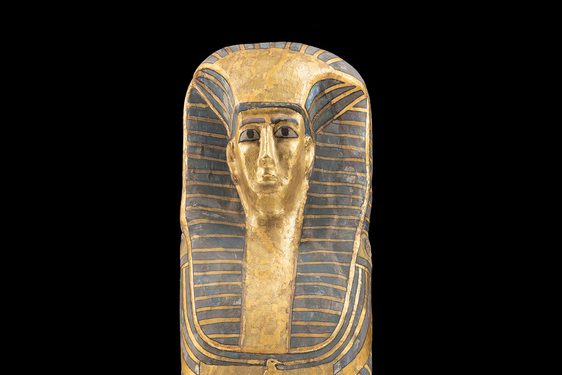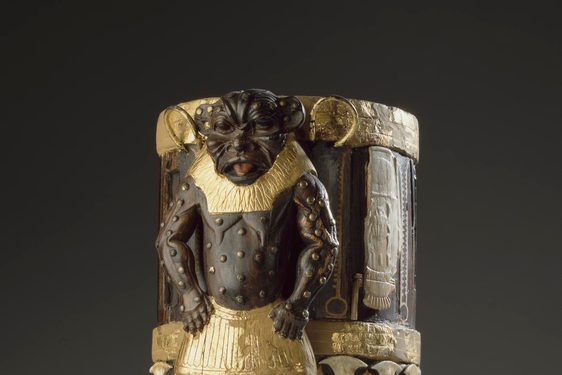
Discovering an ancient Egyptian funerary shroud in museum storage
News Story
A unique 2,000 year old Egyptian funerary shroud was discovered in National Museums Scotland’s collections in 2017. This rare find tells us more about the Roman-era period in Egypt and the people who lived there.
Discovered by curators
The shroud dates to approximately 9 BC and was discovered by curators in 2017 when they were preparing objects for display.
Dr Margaret Maitland, Principal Curator, Ancient Mediterranean, found the folded shroud wrapped in brown parcel paper. Enclosed was a note in a Second World War service envelope, written by a past curator. It identified the contents as having come from an ancient Egyptian tomb. The package had been stored since the mid-1940s.

The shroud is removed from its package by conservators at National Museums Scotland.
Due to the fragility of the ancient textile, Lynn McClean, Principal Conservator, Paper & Textiles, and Irene Kirkwood, Textile Conservator, gently humidified it so that the fibres would become less dry and brittle. This allowed them to carefully unfold the shroud, a process which took almost 24 hours. Upon unfolding it, a hieroglyphic inscription on the shroud revealed the identity of the owner to be the previously unknown son of the Roman-era high-official Montsuef and his wife Tanuat.
Montsuef and Tanuat, along with several other family members, were buried in what is known as the Rhind Tomb. The tomb was originally built around 1290 BC in the necropolis on the west bank of the Nile opposite the great city of Thebes (modern-day Luxor). Discovered by groundbreaking Scottish archaeologist Alexander Henry Rhind, the tomb had been used and reused for over 1000 years before being sealed in the early 1st century AD.
Before we were able to unfold the textile, tantalising glimpses of colourful painted details suggested that it might be a funerary shroud, but none of us could have imagined the remarkable figure that would greet us when we were finally able to unroll it. The shroud is a very rare object in superb condition and is executed in a highly unusual artistic style, suggestive of Roman period Egyptian art, yet still very distinctive.
Dr Margaret Maitland, Principal Curator, Ancient Mediterranean

Funerary shroud of linen painted with a figure of the deceased as the god Osiris, made for Aaemka, son of Montsuef and Tanuat. Museum reference V.2013.45.
Funerary shrouds in Roman Egypt
In ancient Egypt following mummification, a shroud was commonly wrapped around the body before it was placed in a coffin. In Roman-era Egypt, shrouds became increasingly important as the use of coffins became rarer.
This full-length, painted linen shroud is unique, with very few parallels from its period. It depicts the deceased as the god Osiris. Because of its owner’s direct relationship to Montsuef and Tanuat, whose deaths were recorded to have occurred in 9 BC, it is possible to date the shroud relatively precisely, which is extraordinary for such an ancient artefact.

The shroud is unfolded by textile conservators at National Museums Scotland.
The shroud was undisturbed until its excavation in the 19th century when a collection of beautiful objects from various eras was discovered. The shroud is one of a number of objects from the Rhind Tomb which are in National Museums Scotland’s collections.
It is extraordinarily rare that we have such an incredible group of objects belonging to a whole ancient Egyptian family in our collections. To have been able to expand this group of objects with this new discovery is very exciting, and further enhances our understanding of the story of this wonderful tomb and its occupants.
Dr Margaret Maitland, Principal Curator, Ancient Mediterranean
Watch conservation work of the shroud in this short film with Lynn McClean, Principal Conservator, Paper & Textiles, and Margaret Maitland, Principal Curator, Ancient Mediterranean.


